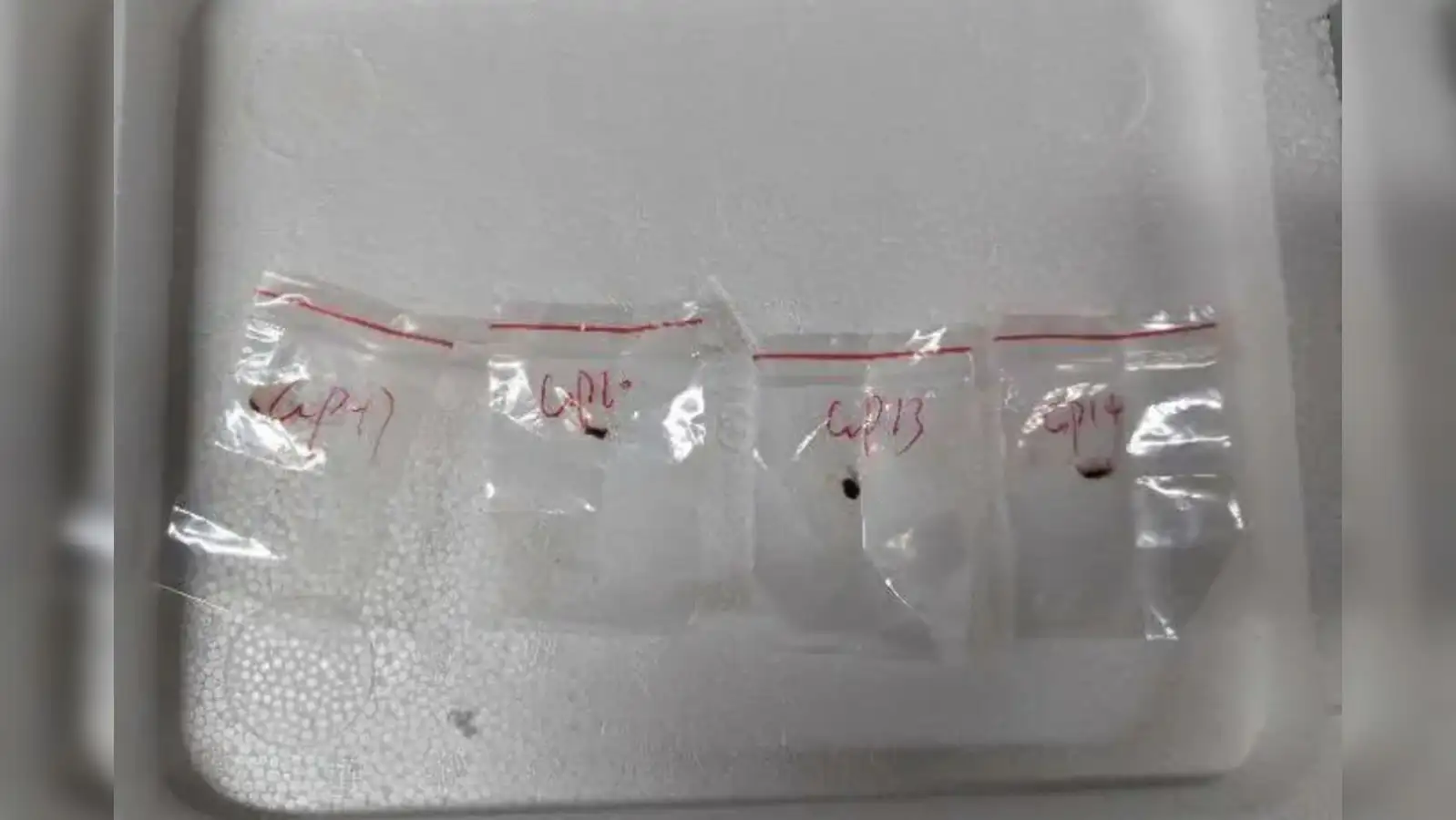News
Who Are the Chinese Scientists Behind the Smuggled Agroterrorism Fungus Plot
Meet the couple at the center of a high-stakes biosecurity scandal that has U.S. officials on edge and the University of Michigan under scrutiny.

In a case that has rattled national security circles and academic institutions alike, two Chinese nationals—Yunqing Jian, 33, and Zunyong Liu, 34—have been charged with smuggling a dangerous biological pathogen into the United States. The pathogen, Fusarium graminearum, is a fungus known to devastate crops like wheat, barley, maize, and rice, and is classified in scientific literature as a potential agroterrorism weapon.
Jian, a postdoctoral research fellow at the University of Michigan since 2022, is alleged to have received funding from the Chinese government for her work on this pathogen in China. Investigators also found evidence on her electronic devices indicating her membership in and loyalty to the Chinese Communist Party (CCP).
Liu, her boyfriend, is a researcher at a Chinese university where he conducts studies on the same fungus. In July 2024, he attempted to enter the U.S. through Detroit Metropolitan Airport carrying concealed samples of Fusarium graminearum in his luggage. Initially denying knowledge of the materials, Liu later admitted he intended to conduct research on the fungus at the University of Michigan lab where Jian worked.
The FBI and U.S. Customs and Border Protection launched a joint investigation, uncovering electronic communications between Jian and Liu discussing the shipment of biological materials and research activities related to the pathogen. The University of Michigan stated it had received no funding from the Chinese government in relation to the research conducted by the accused individuals and is cooperating with federal law enforcement.
Both Jian and Liu face multiple charges, including conspiracy, smuggling goods into the United States, making false statements, and visa fraud. U.S. Attorney Jerome F. Gorgon Jr. emphasized the severity of the case, stating that the alleged actions pose grave national security concerns.
Jian appeared in federal court in Detroit and is currently in custody awaiting further proceedings. Liu was denied entry into the U.S. and returned to China; due to the absence of an extradition treaty between the U.S. and China, his arrest is unlikely unless he returns to American soil.
This incident underscores the vulnerabilities in biosecurity and the potential risks posed by unauthorized research activities involving dangerous pathogens. As investigations continue, the case serves as a stark reminder of the importance of stringent oversight in scientific research and international collaborations.
News
South Carolina judge’s home set ablaze after Trump administration criticism investigators suspect “explosion” amid death threats
Circuit Court Judge Diane Goodstein, who recently faced backlash from the Trump administration over an election data ruling, is recovering after her Edisto Beach home was engulfed in flames — leaving three family members hospitalized.

A horrifying scene unfolded in Edisto Beach, South Carolina, on Saturday morning after the home of Circuit Court Judge Diane Goodstein was set ablaze under what investigators are calling “suspicious circumstances.”
Authorities confirmed that the fire began around 11:30 a.m. ET, injuring three members of the Goodstein family — including her husband, former Democratic state senator Arnold Goodstein, and their son. The occupants had to be rescued by kayak, according to the St. Paul’s Fire District, which responded to the scene.
Judge Diane Goodstein, 69, was not at home during the fire. Sources told FITSNews that she had received multiple death threats in the weeks prior to the blaze. The South Carolina State Law Enforcement Division (SLED) is leading the investigation and has not yet determined whether the fire was accidental or arson.

Explosion suspected
Chief Justice John Kittredge confirmed that preliminary reports suggest the fire may have been triggered by an explosion.
“At this time, we do not know whether the fire was accidental or arson,” Kittredge said. “Until that determination is made, local law enforcement has been ordered to provide extra patrols and security around judges’ residences.”
The incident comes just weeks after Goodstein faced public criticism from the Trump administration for blocking the South Carolina Election Commission from handing over voter registration data to the Department of Justice (DOJ).
Clash with the Trump administration
Last month, Goodstein issued a temporary injunction preventing the release of the state’s voter files — including names, addresses, and Social Security numbers of over three million registered voters — to federal authorities. The DOJ had requested the information as part of President Donald Trump’s March executive order aimed at identifying non-citizens on state voter rolls.
While non-citizens are already prohibited from voting in federal and state elections, critics said the order represented an attempt to federalize state-controlled election systems and suppress marginalized voters.

Goodstein’s ruling was quickly overturned by the South Carolina Supreme Court, but the damage had already been done. Harmeet Dhillon, the Assistant Attorney General for Civil Rights, publicly rebuked the judge, accusing her of “obstructing election integrity.”
Following that, Goodstein began receiving death threats, according to FITSNews, raising concerns about escalating political violence against members of the judiciary.
Pattern of political violence
If investigators confirm that the fire was intentionally set, it would mark another alarming instance in a string of politically motivated attacks across the United States.
In recent months, multiple judges and elected officials have been targeted after rulings unfavorable to the Trump administration:
- Conservative activist Charlie Kirk was murdered last month in what officials described as a politically motivated attack.
- In June, Minnesota House Speaker Melissa Hortman and her husband were killed in their home.
- In April, Pennsylvania Governor Josh Shapiro’s residence was the target of an arson attack.
The Trump White House has faced criticism for its increasingly hostile rhetoric toward judges who rule against its policies. President Donald Trump has repeatedly referred to jurists as “radical left lunatics” and “agitators,” while senior aide Stephen Miller recently accused an Oregon federal judge of “legal insurrection.”
A judiciary under fire
Experts warn that such rhetoric has emboldened extremist threats. In August, Judge Jack McConnell of Rhode Island revealed that his court had received more than 400 threatening voicemails, many referencing Trump’s statements. Judges have even been subjected to “pizza doxxing” — anonymous food deliveries meant to signal that their home addresses have been discovered.
Former federal judge Nancy Gertner, now a professor at Harvard Law School, told The Guardian that inflammatory political language is putting lives at risk.

“There are people inflamed by the incendiary comments of our president and members of Congress about judges,” Gertner said. “Public officials have legitimized attacks on judges with whom they disagree.”
Calls for accountability
In May, more than 150 current and former judges signed an open letter to Attorney General Pam Bondi and FBI Director Kash Patel, urging a federal investigation into the growing number of threats.
“Threats against judges are threats against constitutional government,” wrote Judge Richard Sullivan, a Trump appointee to the U.S. Court of Appeals. “Everyone should be taking this seriously.”
The Department of Justice has yet to comment on the Edisto Beach fire, though a White House spokesperson told NPR that “attacks on public officials have no place in our society.”
Meanwhile, the Goodstein family remains hospitalized as authorities continue to investigate what appears to be one of the most serious acts of political violence against a member of the judiciary this year.
“This is not just an attack on a person,” said one South Carolina legal official. “It’s an attack on the rule of law itself.”
News
DNA evidence finally identifies Robert Eugene Brashers in Austin yogurt shop murders of four teens after 33 years
A breakthrough in forensic testing has linked serial predator Robert Eugene Brashers, who died by suicide in 1999, to the infamous 1991 Austin yogurt shop killings.

More than three decades after one of the most chilling crimes in Texas history, investigators have identified the man responsible for the 1991 Austin yogurt shop murders. On Friday, police confirmed that Robert Eugene Brashers has been definitively linked through DNA evidence to the brutal killing of four teenage girls inside an “I Can’t Believe It’s Yogurt” store.

The breakthrough brings long-awaited answers in a case that has haunted Austin for 33 years.
Who was Robert Eugene Brashers?
Brashers, who died by suicide in 1999 during a police standoff at a Missouri motel, was already suspected of being a violent predator. At the time of his death, he had been hiding with his wife, daughter, and two stepdaughters, all of whom he released before fatally shooting himself.
Subsequent DNA testing connected Brashers to a string of other violent crimes, including multiple rapes and murders in Missouri and South Carolina, and a rape in Tennessee. Authorities have long believed he was a serial offender who evaded justice until his death.

The yogurt shop murders
On December 6, 1991, four teenage girls were killed in what became one of the most infamous crimes in Texas. Victims Amy Ayers, 13; Eliza Thomas, 17; and sisters Jennifer Harbison, 17, and Sarah Harbison, 15, were bound, gagged, and shot execution-style inside the yogurt shop where Thomas and Jennifer worked. The store was then set on fire in an apparent attempt to destroy evidence.
The brutality of the crime shocked Austin and became known nationwide as the “Yogurt Shop Murders.”
Wrongful convictions and overturned cases
In the years that followed, investigators charged Robert Springsteen and Michael Scott, who were teenagers at the time of the crime. Both were convicted in 2001 and 2002, with Springsteen sentenced to death and Scott given life in prison.

But both convictions were later overturned on appeal after courts ruled their confessions had been coerced and, crucially, because no DNA evidence ever tied them to the murders. Both men were released, and the case remained unsolved for years.
Friday’s DNA findings linking Brashers may now close that painful chapter, clearing the names of those wrongfully accused.
Case remains open
Despite the identification of Brashers, the Austin Police Department says the yogurt shop murders investigation is still considered open. Detectives are working to determine whether Brashers acted alone or if others were involved.
READ MORE : Caleb Landry Jones teams up with Peter Sarsgaard and Andrea Riseborough for chilling Don DeLillo film Zero K…
“Our team never gave up working this case,” Austin police said in a statement, adding that they will hold a press conference on Monday to share more details about the DNA breakthrough.
Renewed attention
The case has recently regained national attention following the release of HBO’s docuseries “The Yogurt Shop Murders”, which revisits the tragedy, the botched investigation, and the community’s decades-long wait for justice.
For the families of Amy, Eliza, Jennifer, and Sarah, the new DNA evidence may finally provide long-awaited clarity — though the painful scars of 1991 remain.
News
Million year old skull found in China may rewrite human evolution timeline and challenge our origins
A newly analyzed skull named Yunxian 2 suggests Homo sapiens may have emerged half a million years earlier than previously believed.

A startling new discovery from China is shaking the foundations of what we thought we knew about human origins. Scientists analyzing a skull believed to be around one million years old claim it suggests Homo sapiens – our own species – may have begun to emerge at least 500,000 years earlier than established timelines. If proven correct, this finding would fundamentally rewrite human history.
The fossil, known as Yunxian 2, was unearthed in Hubei Province decades ago but had long been categorized as belonging to Homo erectus, an early human ancestor. However, advanced computer modeling and 3D reconstructions have revealed new insights. Researchers now believe the skull belongs to Homo longi, a sister species on the same evolutionary level as Neanderthals and Homo sapiens.

“Unbelievable” results
The research, published in the prestigious journal Science, was conducted by a team from Fudan University and the UK’s Natural History Museum. Professor Xijun Ni, who co-led the study, admitted that the team was initially skeptical.
“From the very beginning, when we got the result, we thought it was unbelievable. How could that be so deep into the past?” he said. “But we tested it again and again, and we are now confident about the result. We’re actually very excited.”
Professor Chris Stringer of the Natural History Museum added that the find “totally changes our understanding of human evolution.” He suggested that fossils of million-year-old Homo sapiens may already exist, waiting to be identified.

A longer coexistence of human species
If Yunxian 2 is indeed evidence of advanced human development a million years ago, it implies that Homo sapiens, Neanderthals, and Homo longi co-existed for as long as 800,000 years. This is far longer than previously thought, allowing for more interaction, cultural exchange, and even interbreeding.
This theory also helps resolve what scientists have called the “muddle in the middle” – a confusing gap where dozens of fossils dated between 800,000 and 100,000 years ago did not fit neatly into the human family tree. By pushing back the timeline, these fossils may now be grouped as sub-branches of the “big three” human species or their direct ancestors.
ALSO READ: Alyssa Milano removes breast implants says she finally feels free and authentic
Skepticism remains
Not all experts are fully convinced. Dr. Aylwyn Scally, an evolutionary geneticist at Cambridge University, warned that dating methods are notoriously difficult and that the findings, while plausible, remain uncertain.
“One has to be particularly tentative about the timing estimates,” Scally explained. “Even with the largest amount of genetic data, it is very difficult to place a time when these populations may have co-existed to within 100,000 years or more.”

A broader origin story
Traditionally, the earliest known fossils of Homo sapiens come from Africa, dating back around 300,000 years. But this Chinese discovery suggests Asia may have played a larger role in our evolutionary story than once believed. Still, scientists emphasize the need for more data before rewriting textbooks.
A new branch of the tree
Professor Ni compared human evolution to a tree with multiple branches: “There were three major branches – Homo sapiens, Neanderthals, and Homo longi. They may have interbred, and they coexisted for almost a million years. This is an unbelievable result.”
By using modern scanning techniques, his team restored Yunxian 2 and two other damaged skulls to their original shape, allowing for the groundbreaking reclassification.
For now, Yunxian 2 is being hailed as one of the most important fossil discoveries in decades. Whether it truly represents an earlier emergence of our species or a closely related branch of humanity, the debate it sparks is certain to reshape the future of human evolutionary research.
-

 Entertainment1 week ago
Entertainment1 week agoDolly Parton delays Las Vegas concerts by nine months citing health challenges but promises unforgettable return
-

 Entertainment1 week ago
Entertainment1 week agoZoey Deutch engaged to comedian Jimmy Tatro after 4 years of dating with romantic beach proposal
-

 Entertainment4 days ago
Entertainment4 days agoSurvivor Season 49 episode 2 shocker Kele tribe loses again and fans stunned by who went home
-

 Sports3 days ago
Sports3 days ago‘Silent killer’ Cam Schlittler stuns Red Sox as Yankees rookie makes history with 12 strikeouts
-

 Crime & Justice5 days ago
Crime & Justice5 days agoProsecutors demand 11 years for Diddy after shocking trial says Cassie’s testimony revealed dark truth
-

 Politics1 week ago
Politics1 week agoBarack Obama blasts Trump over Tylenol autism claim calling it ‘violence against truth’ but that’s not all he said…
-

 Sports5 days ago
Sports5 days agoTottenham’s Champions League wake-up call… why Spurs must stop looking like a Europa League side
-

 Sports2 days ago
Sports2 days agoShohei Ohtani finally pitches in MLB playoffs after 2,746 days… will this be the moment that defines Dodgers vs Phillies?





























Pingback: Did Two Chinese Scientists Just Try to Smuggle a Bio Weapon into America - Daily Global Diary